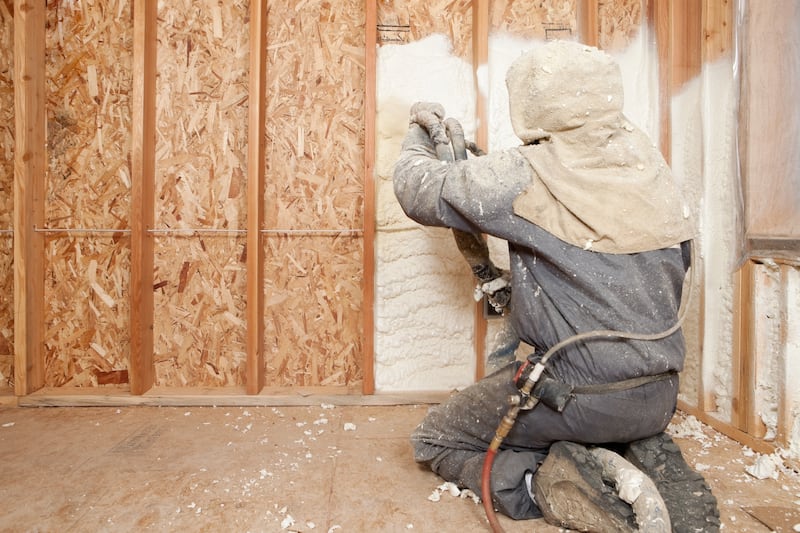It’s considered one of the best ways of improving the energy-efficiency of your home, as by design it can access difficult spaces such as cavities in walls and attics.
However, some 300,000 homeowners in the UK who have installed spray foam insulation in their homes are now finding themselves in a tight spot, with banks putting restrictions on mortgages to properties that have it installed, and lenders refusing to offer equity release on such homes.
In the Republic, the Sustainable Energy Authority of Ireland (SEAI) continues to offer grant funding for this type of insulation – but building surveyors have their own warnings for Irish homeowners.
So, if you have spray foam insulation, should you be worried? And if you’re thinking about it, should you think twice?
READ MORE
What is it?
Spray foam insulation is a form of retaining warmth in your home, an alternative to external cladding or internal warm boards. It has been around for more than 30 years and involves liquid foam being spray-gunned into roof spaces and walls. Once inserted, the foam expands to fill gaps and insulates against the cold. It is typically used to insulate roofs and attics.
Estimates suggest it costs about €20-35 per sq m, plus VAT, for installation.
“The apparent ease of installation and ability to access difficult spaces in a continuous layer over traditional methods makes a ‘high tech’ spray system appear to be appealing,” says Fergus Merriman, chartered building surveyor, owner of Merriman Solutions, and a member of the Society of Chartered Surveyors Ireland (SCSI).
However, when not installed correctly, it can cause problems. And even if it is installed appropriately, it can hide issues, leading to potentially greater ones down the line.
UK experience
Indeed, a report from the UK government’s Health and Safety Executive, published in March of this year, found that when applied at rafter level to timber-sloped roofs, this insulation may create and/or conceal moisture problems.
“Such problems in this region could potentially lead to decay of the roof timbers and surrounding fabric elements,” the report found.
It estimated that 25 per cent of roof timbers could decay within five years if spray foam was applied directly to roof tiles, or certain underlays. And the further north affected properties are, the greater the potential problems, given the weather.
In a guidance document, the Royal Institution of Chartered Surveyors (RICS) adds that some spray foam insulation can make it difficult to identify problems in a roof because it restricts the view inside, meaning the roof cannot be fully seen or inspected.
“If there’s a roof leak behind some types of spray foam insulation, you may not notice it. An undetected roof leak can lead to rotting timber,” it warns.
Merriman says most of the issues result from “bad workmanship, wrong material or inappropriate use”, but that in some cases, its use has led to “catastrophic structural failure”.
No wonder then, perhaps, that lenders in the UK, unable or unwilling to inspect the quality of the work, are simply issuing blanket refusals on any properties which have spray foam insulation.
[ Is spray foam the best way to insulate our attic?Opens in new window ]
One homeowner noted in a story in the Guardian that despite the insulation in her loft conversion being signed off by the local council some 10 years ago, when she tried to sell the house, she was told that the “value is essentially zero until we have the foam stripped out”.
This means that if you’re looking to sell your home in the UK, you might find it difficult, as a buyer purchasing with a mortgage may be unable to proceed. You might also struggle to either remortgage or release equity on your home, if looking to do that.
“Uncertainty over their effects, unforeseen outcomes and the growing number of costly repair issues now coming to light from these systems is adding to the level of risk being faced by companies offering mortgages and insurance,” says Merriman.
A spokesman for UK lender Nationwide told us that while it will lend on properties with spray foam insulation, it may require a surveyor’s report before it does so.
“We have seen instances of spray foam having been installed in roof spaces in a manner that does not comply with manufacturer’s recommendations and, in such circumstances, there is an inherent risk of causing damage to the roof structure,” he says. In such cases, where a valuer sees evidence of spray foam, the lender “will require documentary evidence that it has been installed correctly before we will lend.”
We also asked the UK operations of HSBC about its lending policy. It said that while spray foam to roof spaces is “unacceptable” for any listed buildings, for other properties it may be acceptable “if a suitable specialist report (in accordance with Property Care Association protocols) confirms it has been suitably installed and warranty is provided”.
When it comes to equity-release lenders, however, according to the HomeOwners Alliance (HOA), none will lend on a property with spray foam roof insulation installed, most likely because they may end up owning the property in full in future years.
It is not easy to remove the foam, which is an added challenge for homeowners.
“The systems are designed to stick fast to whatever they are sprayed on to, making it very difficult to remove,” says Merriman. In the UK, homeowners have been quoted about €4,000 for removal.
Spray foam in Ireland

But what is the situation here?
Some issues with spray foam have already been identified. In 2020, the High Court awarded damages of some €2 million to a couple who claimed they were exposed to toxic chemicals after spray foam insulation was installed in their home.
While the judge found that spray foam is “essentially safe” if properly applied with the proper safeguards, these were not applied in this case.
However, despite this and the experience in the UK, not much has changed here.
“Spray foam is not currently a factor in relation to mortgage declines,” a spokesman for Bank of Ireland said, while AIB said it is not aware of any issues in relation to spray foam.
A spokesman for Spry Finance, which arranges equity release loans, says the use of the insulation “is not an issue that has arisen”.
Home insurer Aviva says it doesn’t impose restrictions, “provided the materials used comply with required regulations and are applied in line with manufacturers’ specifications”.
It is also still possible to avail of a grant towards the installation of such insulation.
According to the SEAI, which is responsible for the energy upgrade grant scheme, it still offers grants for various types of certified attic (ceiling or rafter level) insulation, including spray foam, ranging from €800 to €3,000.
This has been a big bugbear for UK homeowners – the fact that spray foam insulation was available through government grants.
So what does the SEAI think of developments in the UK?
While it agrees with the findings of the UK’s March report, that an air and vapour control layer, or AVCL, be provided on the warm side of the insulation as well as a ventilated space between the insulation and roof underlay, it says such issues are mitigated against in an Irish context “by the AVCL and ventilation requirements of the Irish Agrément certificates, and technical requirements of SEAI grant schemes”.
Indeed, all providers covered by the grant scheme must be registered with the SEAI, and must follow relevant standards of practice. In relation to spray foam insulation, it must be Irish Agrément Certified, which guarantees that the material and installation are suitable for Irish dwelling types and climate, in line with Irish building regulations.
“Each installer of spray foam must be trained by the manufacturer to install as required by the Agrément certification,” a spokesman says.
‘Think long and hard’
In any case, given the UK experience, construction experts advise caution for anyone considering investing in this type of insulation.
While Merriman concedes that, depending on the building, there “may be a case for using spray foam”, in general, he would avoid it.
“Given the ongoing question marks over these products and the potential knock-on effects regarding insurance and mortgages, I would advise people to think long and hard before going down the spray foam route,” he says.
- Sign up for push alerts and have the best news, analysis and comment delivered directly to your phone
- Join The Irish Times on WhatsApp and stay up to date
- Listen to our Inside Politics podcast for the best political chat and analysis






















